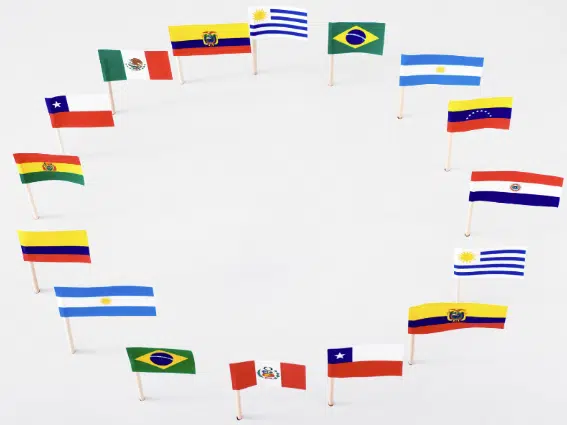Companies seeking experienced native Spanish-speaking translators to proofread or translate content can find English to…
How Many Spanish Dialects Are There?
Spanish is one of the most widely spoken languages in the world, with over 460 million native speakers across various continents. There are over 20 distinct Spanish dialects spoken globally, each with unique accents, vocabulary, and grammar. These regional variations can be particularly important when translating documents for business or legal purposes.

Join our Spanish translation experts as we explore the most commonly spoken Spanish dialects.
Whether you’re looking to connect with clients, customers, or partners, understanding how many Spanish dialects there are can help ensure your message is clear and culturally appropriate.
What is a Spanish Dialect?
A Spanish dialect is a regional variation of the Spanish language, with differences in pronunciation, vocabulary, and grammar. These differences arise from historical, cultural, and geographical factors. While all Spanish dialects share the same root language, they can vary from country to country or even within different regions of the same country.
Common Spanish Dialects Spoken in the United States
The United States is home to a large and diverse Spanish-speaking population. Due to immigration patterns, cultural influences, and regional differences, several Spanish dialects are commonly spoken across the country.
Mexican Spanish
Mexican Spanish is the most widely spoken Spanish dialect in the U.S., largely due to the significant Mexican-American population. Mexican Spanish is known for its clear pronunciation, with a strong emphasis on the “s” sound. It also features unique vocabulary, such as words like “chido” (cool), “güey” (dude), and “cuate” (friend), which distinguish it from other Spanish dialects.
Mexican Spanish is predominantly spoken in states like California, Texas, Arizona, New Mexico, and Illinois. It also has a strong presence in other parts of the U.S. due to the large Mexican immigrant community.
Caribbean Spanish
Caribbean Spanish includes dialects spoken in Puerto Rico, Cuba, and the Dominican Republic. It is characterized by rapid speech, dropping of certain consonants, and distinct vocabulary influenced by African and indigenous Caribbean languages. Common words include “chévere” (cool), “pana” (friend), and “guagua” (bus).
Caribbean Spanish is predominantly spoken in states like Florida, New York, New Jersey, and other areas with large Puerto Rican, Cuban, and Dominican communities.
Southwestern Spanish
Southwestern Spanish is a blend of Mexican Spanish influences and regional U.S. variations. This dialect is marked by clear pronunciation, but with some regional expressions and vocabulary, including words like “bajón” (craving) and “chido” (cool), which are common in the southwestern U.S.
This dialect is commonly spoken in states like Texas, New Mexico, Arizona, and Southern California, where there is a strong Mexican and Mexican-American presence.
Central American Spanish
Central American Spanish is spoken by immigrants from countries like Guatemala, El Salvador, and Honduras. It is known for its softer pronunciation and distinct vocabulary, including words like “pisto” (money) and “chucho” (dog).
Central American Spanish dialects are commonly spoken in areas of the U.S. with large Central American immigrant populations, such as California, Texas, and Florida.
Spanish Dialects Spoken in Central and South America
Central and South America are home to a diverse range of Spanish dialects, each influenced by the region’s unique history, culture, and indigenous languages.
While the core of the language remains the same, each country has developed its own variations in pronunciation, vocabulary, and grammar.

Andean Spanish
Andean Spanish is known for its clear pronunciation and relatively neutral accent. This dialect is often more formal, avoiding slang, and uses vocabulary such as “parce” (friend) and “bacán” (cool). It is considered easier to understand by Spanish speakers from other regions.
Andean Spanish is spoken in countries like Colombia, Ecuador, Peru, and Bolivia—with it predominantly spoken in the Andean mountain regions. However, its influence can be found throughout these countries, especially in urban centers like Bogotá, Quito, Lima, and La Paz.
Rioplatense Spanish
Rioplatense Spanish dialect is distinctive for its use of “voseo” (using “vos” instead of “tú” for the informal second-person singular pronoun) and a more Italian-influenced intonation. Words like “che” (hey) and “laburar” (to work) are common in this dialect.
Rioplatense Spanish is most commonly spoken in Argentina, Uruguay, and parts of Paraguay, particularly in cities like Buenos Aires, Montevideo, and Asunción.
Chilean Spanish
Chilean Spanish is known for its distinct pronunciation, which can sound quite different from other Spanish dialects. Chileans often shorten words, use a lot of slang, and have unique vocabulary, such as “po” (used for emphasis) and “bacán” (cool). The rhythm of Chilean Spanish is also faster compared to other regions.
Chilean Spanish is primarily spoken in Chile, especially in the capital, Santiago, as well as in coastal areas.
Mexican and Caribbean Spanish
While already covered in the U.S. section, it’s worth noting that both Caribbean and Mexican Spanish dialects have regional variations within Mexico and the rest of Central America. In central and southern Mexico, the dialect is marked by a clearer pronunciation, with some differences in vocabulary usage, as these areas also have significant influences from indigenous populations.
Spanish Dialects in Spain and Other European Regions
Spain and other European regions where Spanish is spoken have a variety of dialects that reflect historical and regional diversity. While Castilian Spanish is the official and most widely recognized form, several other dialects exist, each shaped by local cultures, indigenous languages, and centuries of influence from neighboring countries.
Castilian Spanish
Castilian Spanish is the standard and most widely spoken dialect in Spain. It is the version of Spanish taught in schools and used in formal settings across the country. Castilian Spanish is known for its clear pronunciation and distinct phonetic features, such as the “th” sound in words like “gracias” (thank you) and “cielo” (sky), which distinguishes it from other dialects like those in Latin America.
Castilian Spanish is predominantly spoken throughout Spain, especially in the central and northern regions, including cities like Madrid and Valladolid. It is also the foundation for the Spanish language used in global media, literature, and education.
Andalusian Spanish
Andalusian Spanish is spoken in the southern region of Spain, particularly in Andalusia. This dialect is known for its distinct pronunciation, including the softening or dropping of certain consonants, such as the “s” sound at the end of syllables. For example, “este” (this) may be pronounced as “ehte.” Andalusian Spanish also features a more relaxed and rapid speech pattern compared to Castilian Spanish.
Andalusian Spanish is primarily spoken in the southern provinces of Spain, including cities like Seville, Granada, and Málaga. It is also influential in Latin American dialects, particularly in countries like Argentina, where the accent and vocabulary are sometimes linked to Andalusian roots.
Canarian Spanish
Canarian Spanish is spoken in the Canary Islands, an autonomous community of Spain located off the northwest coast of Africa. This dialect shares many similarities with Caribbean Spanish due to historical trade and migration connections, resulting in a smoother, more fluid pronunciation. One notable feature of Canarian Spanish is the tendency to soften or drop the “s” sound at the end of syllables, similar to Caribbean Spanish.
This dialect is predominantly spoken in Tenerife, Gran Canaria, and Lanzarote, and has an influence on the Spanish spoken in Latin American countries, particularly in Cuba and the Dominican Republic.
The Importance of Understanding Spanish Dialect Differences for Translation

Understanding Spanish dialect differences is crucial for ensuring accurate and culturally appropriate translations.
Spanish is spoken in various regions worldwide, and each dialect has unique features that can impact the meaning and tone of translated content.
Below are key reasons why recognizing these dialectal variations is essential for translation.
Accurate Communication
Each Spanish dialect has distinct vocabulary, expressions, and slang. Using the wrong regional terms or phrases could lead to confusion or misinterpretation.
For example, the word “torta” means “cake” in Spain but refers to a sandwich in Mexico, so understanding these differences ensures that the intended message is clear.
Cultural Sensitivity
Cultural context plays a vital role in language, and dialects often reflect local customs and traditions. A translation that ignores these cultural nuances may appear out of place or even disrespectful.
Being aware of the dialect spoken by the target audience helps ensure that a translated website or translated marketing material resonates with the culture it’s intended for.
Target Audience Engagement
Tailoring your translation to the dialect spoken by your target audience can make your message more relatable and engaging. For instance, using Mexican Spanish terms for a product aimed at a Mexican audience will connect better than using a neutral or European Spanish tone. Dialect-specific translations help businesses build stronger connections with their customers.
Professionalism and Accuracy in Legal and Other Professions
In fields like law and medicine, precise language is critical. Using the correct dialect ensures that terms and instructions are understood correctly, reducing the risk of legal or medical errors.
A small mistake on a translated legal document or in safety manual translations could result in significant misunderstandings. Specialized knowledge of regional variations is essential for professional translators.
Contact Our Professional English to Spanish Translators Today
Ensure your message is accurately translated for your audience with our expert team at English to Spanish Raleigh. Our Spanish speaking translation team specializes in providing high-quality translations tailored to specific Spanish dialects.
Whether you need legal, medical, or business documents translated, we ensure your content is appropriate and precise.
Contact us today by calling 919-629-0020 or filling out our online contact form to get started.
Related Posts
- Raleigh Spanish Translation Company is Moving!
- Bad Spanish Translation Example
This English and Spanish version sign was spotted in a shopping center of a major…
- English to Spanish Translation is the Job for Experts
Imagine how your business can fare when you get the English to Spanish translation done…
